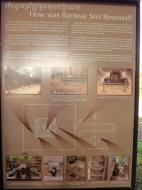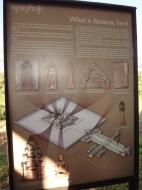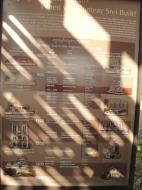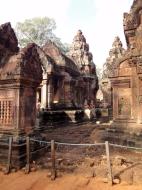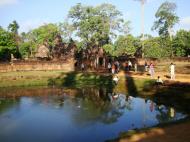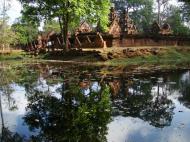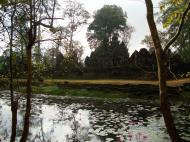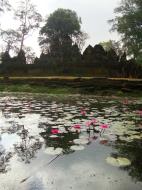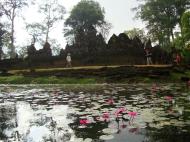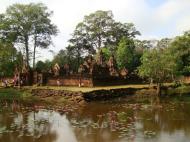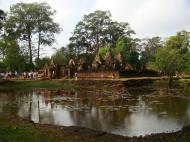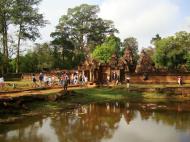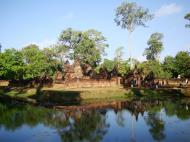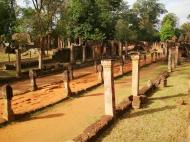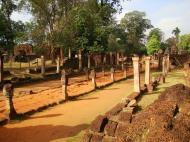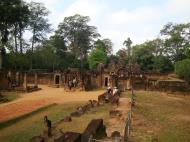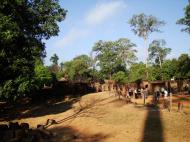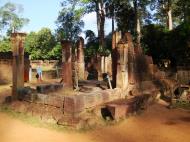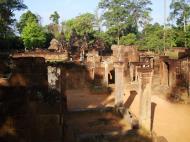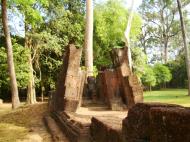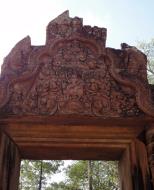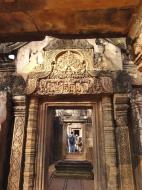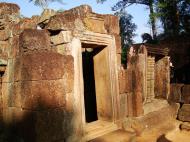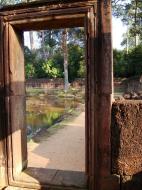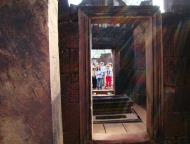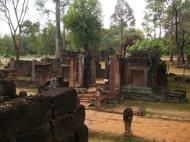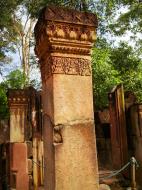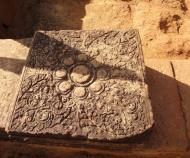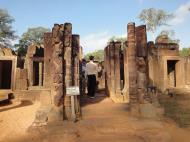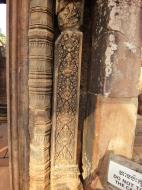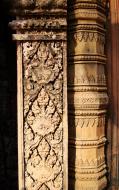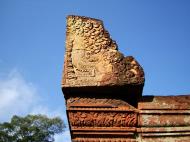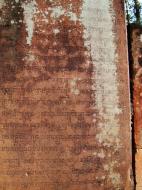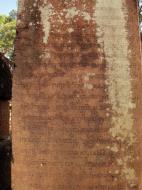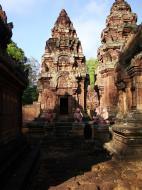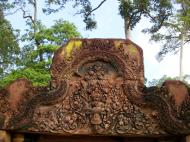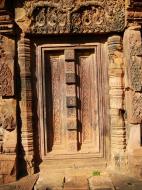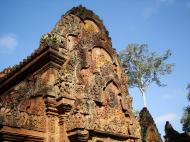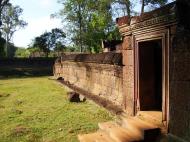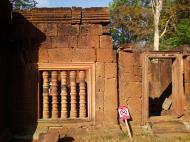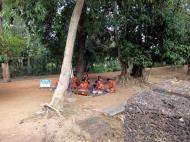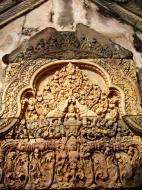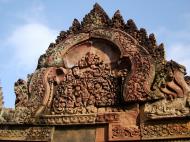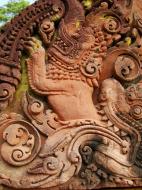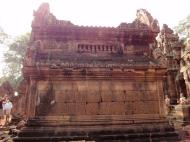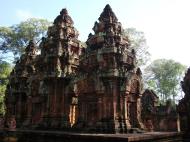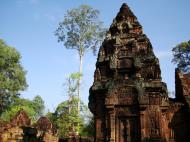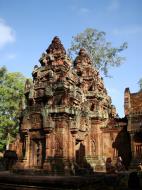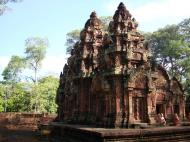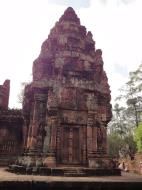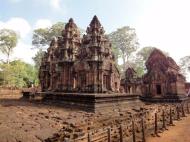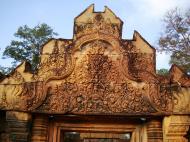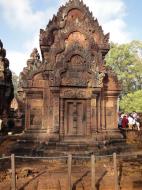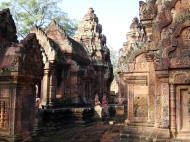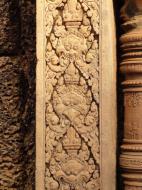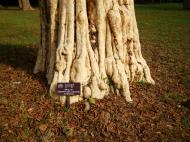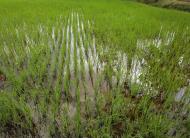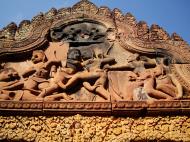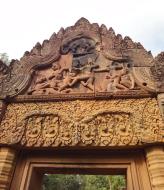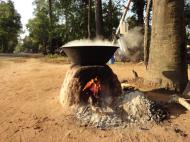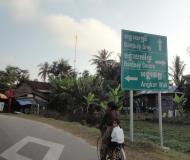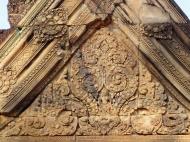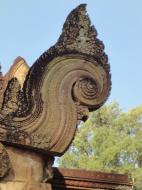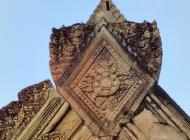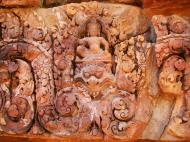Banteay Srei
Date of Construction: Late 10th century C.E.
Religious Affiliation: Hinduism
Patron or King: Rajendravarman
Artistic/Archeo. Style: Banteay Srey
Location: Outside the main Park area. 37 kms north of Siem Reap
Photography Notes: Many of the carvings are roped off. Bring a telephoto lens and tripod for carving shots.
Position: 13d35'56N 103d57'46EBanteay Srei loosely translates to citadel of the women, but this is a modern appellation that probably refers to the delicate beauty of the carvings.
Built at a time when the Khmer Empire was gaining significant power and territory, the temple was constructed by a Brahmin counselor under a powerful king, Rajendravarman and later under Jayavarman V.
Banteay Srei displays some of the finest examples of classical Khmer art.
The walls are densely covered with some of the most beautiful, deep and intricate carvings of any Angkorian temple.
The temple was discovered by French archaeologists relatively late, in 1914.
From Angkor: The tenth century temple of Banteay Srei is renowned for its intricate decoration carved in pinkish sandstone that covers the walls like tapestry.
The special charm of this temple lies in its remarkable state of preservation, small size and excellence of decoration.
A special feature of the exquisite decoration was the use of hard pink sandstone (quartz arenite) which enabled the technique of sandalwood carving with even an Indian scent to it.
Architectural and decorative features of Banteay Srei are unique and exceptionally fine.
The architecture is distinguished by triple superimposed frontons with relief narrative scenes carved in the tympanums, terminal motifs on the frames of the arches, and standing figures in the niches.
Panels are decorated with scenes inspired by Indian epics, especially the Ramayana and its execution has a liveliness not seen in the more formal decoration of earlier temples.
Banteay Srei (is a 10th century Cambodian temple dedicated to the Hindu god Shiva.
Banteay Srei is built largely of red sandstone, a medium that lends itself to the elaborate decorative wall carvings which are still observable today.
The factors have made the temple extremely popular with tourists, and have led to its being widely praised as a precious gem, or the jewel of Khmer art.
Banteay Srei (Citadel of Women) is the modern name of a 10th century Khmer temple originally called Tribhuvanamahesvara (Great Lord of the Threefold World), an appellation of the god Siva.
Consecrated in 967 A.D., Banteay Srei was the only major temple at Angkor not built by a monarch; its construction is credited to a courtier named Yajnavaraha, who served as a counsellor to king Rajendravarman.
The temple was surrounded by a town called Isvarapura.
It has been speculated that the temple's modern name, Banteay Srei, is due to the many devatas carved into the red sandstone walls.
Yajnyavaraha's temple was primarily dedicated to the Hindu god Shiva.
The temple buildings appear to be divided along the central east-west axis between those buildings located south of the axis, which are devoted to Shiva, and those north of the axis, which are devoted to Vishnu.
The temple's modern name, Banteay Srei - citadel of the women, or citadel of beauty - is probably related to the intricacy of the bas relief carvings found on the walls and the tiny dimensions of the buildings themselves.
Some have speculated that it relates to the many devatas carved into the walls of the buildings.
It came under the control of the king and had its original dedication changed; an inscription of the early twelfth century records the temple being given to the priest Divarakapandita and being rededicated to Shiva.
The temple was rediscovered only in 1914, and was the subject of a celebrated case of art theft when André Malraux stole four devatas in 1923 (he was soon arrested and the figures returned).
The incident stimulated interest in the site, which was cleared the following year, and in the 1930s Banteay Srei was restored in the first important use of anastylosis at Angkor.
Measures were also taken to prevent damage to the temples walls being caused by nearby trees.
The temple has been ravaged by pilfering and vandalism.
When toward the end of the 20th century authorities removed some original statues and replaced them with concrete replicas, looters took to attacking the replicas.
Banteay Srei is built largely of a hard red sandstone that can be carved like wood.
The temple is known for the beauty of its sandstone lintels and pediments.
At Banteay Srei, pediments are relatively large in comparison to the openings below, and take a sweeping gabled shape.
The lintels at Banteay Srei are beautifully carved, rivalling those of the 9th century Preah Ko style in quality.
Noteworthy decorative motifs include the kala (a toothy monster symbolic of time), the guardian dvarapala (an armed protector of the temple) and devata (demi-goddess), the false door, and the colonette.
At Banteay Srei, wrote Glaize, the work relates more closely to the art of the goldsmith or to carving in wood than to sculpture in stone.
Like most Khmer temples, Banteay Srei is oriented towards the east.
It consists of three concentric rectangular enclosures constructed on an east-west axis.
A causeway stituated on the axis leads from an outer gopura, or gate, to the third or outermost of the three enclosures.
The inner enclosure contains the sanctuary, consisting of an entrance chamber and three towers, as well as two buildings conventionally referred to as libraries.
The gopura's eastern pediment shows Indra, who was associated with that direction, mounted on his three-headed elephant Airavata.
The 67 m causeway with the remains of corridors on either side connects the gopura with the third enclosure.
The pediment representing the fight between the asura brothers Sunda and Upasunda over the apsara Tilottama is located in the Musée Guimet.
The third enclosure is 95 by 110 m; it is surrounded by a laterite wall breached by gopuras at the eastern and western ends.
Neither pediment of the eastern gopura is in situ.
The west-facing pediment is now located in the Musée Guimet in Paris.
The east-facing pediment is lying on the ground.
Most of the area within the third enclosure is occupied by a moat divided into two parts by causeways to the east and west.
The second enclosure sits between an outer laterite wall measuring 38 by 42 m, with gopuras at the eastern and western ends, and a brick inner enclosure wall, measuring 24 by 24 m.
The western gopura features an interesting bas relief depicting the duel of the monkey princes Vali and Sugreeva, as well as Rama's intervention on Sugreeva's behalf.
The inner enclosure wall has collapsed, leaving a gopura at the eastern end and a brick shrine at the western.
The eastern pediment of the gopura shows Shiva Nataraja; the west-facing pediment has an image of Durga.
The laterite galleries which once filled the second enclosure (one each to north and south, two each to east and west) have partially collapsed.
A pediment on one of the galleries shows the lion-man Narasimha clawing the demon Hiranyakasipu.
Between the gopuras on the collapsed inner wall are the buildings of the inner enclosure: a library in the south-east corner and another in the north-east corner, and in the centre the sanctuary set on a T-shaped platform 0.9 m high.
Besides being the most extravagantly decorated parts of the temple, these have also been the most successfully restored (helped by the durability of their sandstone and their small scale).
As of 2005, the entire first enclosure was off-limits to visitors, as was the southern half of the second enclosure.
Each library has two pediments, one on the eastern side and one on the western.
According to Maurice Glaize, the four library pediments, representing the first appearance of tympanums with scenes, are works of the highest order.
The east-facing pediment on the southern library shows Shiva seated on the summit of Mount Kailasa, his mythological abode.
His consort Uma sits on his lap and clings anxiously to his torso.
Other beings are also present on the slopes of the mountain, arranged in a strict hierarchy of three tiers from top to bottom.
In the top tier sit bearded wise men and ascetics, in the middle tier mythological figures with the heads of animals and the bodies of humans, and in the bottom tier large animals, including a number of lions.
According to the legend, Shiva stopped Ravana from shaking the mountain by using his toe to press down on the mountain and to trap Ravana underneath for 1000 years.
Uma sits to Shiva's right; he is handing her a chain of beads.
The slopes of the mountain are crowded with other beings, again arranged in a strict hierarchy from top to bottom.
Just under Shiva sit a group of bearded wise men and ascetics, under whom the second tier is occupied by the mythological beings with the heads of animals and the bodies of humans; the lowest tier belongs the common people, who mingle sociably with tame deer and a large gentle bull.
According to the legend, Kama fired an arrow at Shiva in order to cause Shiva to take an interest in Uma.
Shiva was greatly angered by this provocation, and punished Kama by gazing upon him with his third eye, frying Kama to cinders.
The east-facing pediment on the northern library shows the god of the sky Indra creating rain to put out a forest fire started by the god of fire Agni for purposes of killing the naga king Takshaka who lived in Khandava Forest.
The Mahabharatan heroes Krishna and Arjuna are shown helping Agni by firing a dense hail of arrows to block Indra's rain.
Takshaka's son Aswasena is depicted attempting to escape from the conflagration, while other animals stampede about in panic.
The west-facing pediment on the southern library depicts Krishna slaying his wicked uncle Kamsa.
The sanctuary is entered from the east by a doorway only 1.08 m in height: inside is an entrance chamber (or mandapa) with a corbelled brick roof, then a short corridor leading to three towers to the west: the central tower is the tallest, at 9.8 m. Glaize notes the impression of delicacy given the towers by the antefixes on each of their tiers.
Banteay Srei Siem Reap, Cambodia Map
 Editor for Asisbiz: Matthew Laird Acred
Editor for Asisbiz: Matthew Laird Acred
If you love our website please add a like on facebook
Please donate so we can make this site even better !!
